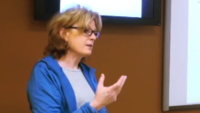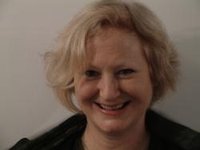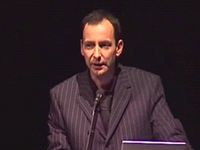
Frances Dyson (AU) is Emeritus Professor of Cinema and Technocultural Studies at the University of California, Davis, and Visiting Professorial Fellow at the National Institute for Experimental Arts, University of New South Wales. She is the author of The Tone of Our Times: Sound, Sense, Economy and Ecology (MIT Press, 2014); Sounding New Media: Immersion and Embodiment in the Arts and Culture (University of California Press, 2009)
“Art: Sound: Matter”
Now that “sound art” is an accepted form within the gallery, it is timely to explore current relations between “art”; “sound,” and “matter.” In this talk I discuss some of the discursive and aesthetic contributions that sound makes to the broader cultural and eco-political fields. Questioning how sound relates to and perhaps challenges symbolic regimes within art and culture; how sonic materialities impact on physical and social infrastructures; and the mode of understanding that the sonic arts engenders, the talk offers some speculations on an aurally inspired understanding of what matters, and how to know what matters.

Cathy Lane (UK) is an artist and academic. Her work uses spoken word, field recordings and archive material to explore aspects of our listening relationship with each other and the multiverse. She is currently focused on how sound relates to the past, our histories, environment and our collective and individual memories from a feminist perspective. Cathy is Professor of Sound Arts and University of the Arts London and co-director of CRiSAP ( Creative Research in Sound Arts Practice).
"Why not our voices? New listenings and new worlds in the sonic imaginary"
We live in sound, it is all around us. We are implicated in the social relationships and ideologies that we hear reflected back to us. Sound art offers the chance to critique the world that we hear and to produce new and different possibilities. Are sound artists taking up the challenge of offering new ways of knowing or changing the world and does this need new ways of listening and understanding? Can sound art or listening act as tools for radical change by ‘de-conditioning’ our listening and help us cross linguistic, cultural, geographic, ethnic, gendered, specied and sexual prejudicial borders? This presentation will consider how a new listenings might lead to a richer more inclusive sound art that can embrace and celebrate difference.
We live in sound, it is all around us. We are implicated in the social relationships and ideologies that we hear reflected back to us. Sound art offers the chance to critique the world that we hear and to produce new and different possibilities. Are sound artists taking up the challenge of offering new ways of knowing or changing the world and does this need new ways of listening and understanding? Can sound art or listening act as tools for radical change by ‘de-conditioning’ our listening and help us cross linguistic, cultural, geographic, ethnic, gendered, specied and sexual prejudicial borders? This presentation will consider how a new listenings might lead to a richer more inclusive sound art that can embrace and celebrate difference.

Wolfgang Ernst (DE) is Professor of Media Theory at the Institut für Musik und Medienwissenschaft at Humboldt University, Berlin, where he co-runs the Media Archaeological Fundus. He is the author of Digital Memory and the Archive (2012) and Sonic Time Machines: Explicit Sound, Sirenic Voices and Implicit Sonicity (2015).
"LISTENING TO SONIC EXPRESSIONS WITH MEDIA-ARCHAEOLOGICAL EARS"
This talk will not be intended as a contribution to "sound studies", but rather turns the notion of sound upside down in order to reveal, below its apparent auditory phenomena, its epistemological essence which is an articulation of specific tempor(e)alities. Therefore "implicit sonicity" will be addressed, not simply to make verbally explicit what is already articulated in sound art, but rather revealing the hidden epistemological implications of sound itself. While sound as acoustic vibration is a physically material event, in its temporal form ("implicit sonicity") which affects the human sense of time it is volatile and immaterial. The almost immaterial sonicity of electro-magnetic waves make "sound matters" not simply a phenomenon in acoustic culture but a fundamental event of being-in-the-world.
This involves a critical analysis of the asymmetrical relation between "sound" (as signal event) and "music" (as code) - which is turned upside down with "digital" sound which is the mathematization of sonic matter - thereby a re-entry of a "musical" structure. According to Norbert Wiener's seminal definition, information - measured in bits - is "neither energy nor matter". Is the current interest in sound a "post-digital" nostalgia for vibrational matter? Different from "music" (in the Pythagorean tradition), sound can not be reduced to a cultural-discursive construction. The agency of emancipating sound from music is media-epistemological indeed: It has been signal recording technologies and media theories (avant la lettre) which heightened awareness of the physicality of sound as vibrational event (both mechanical and electro-magnetic). In terms of ontological unrevealing, it is techno-logical analysis (such a spectrography and Fast Fourier Analysis) which as a better "understanding" of sound matters than human hearing itself.

Brian Kane (US) is an Associate Professor on Term in the Department of Music, Yale University. He is the author of Sound Unseen: Acousmatic Sound in Theory and Practice (2014). Trained as a composer and philosopher, his research aims to integrate the history and theory of music with broader currents in sound studies and critical theory. He is a founding editor at nonsite.org and on the editorial board of Journal of Music Theory. His newest project is Hearing Double: Jazz, Ontology, Auditory Culture, forthcoming from Oxford University Press.
"Lines, Webs, Whirls: on Music, Sound Art, and Metatheory"
Any theory of sound art that considers the latter as a distinct, coherent domain of artistic practice must consider its relation to music. Many recent theories have suffered from a condition that I call “musicophobia,” a theoretical “othering” of music in order to make room for sound art’s distinctness and coherence. Developing my previous challenge to musicophobic theories of sound art, this talk aims to reconsider the relation of sound art to music according to three distinct figures: lines, such as those drawn between sounds and tones, notes and noise, percepts and concepts; webs, such as those that bring together networks of actors, agents, techniques, technologies, institutions, and influences; and whirls, such as those “whirls of organism”—to borrow a phrase from Stanley Cavell—that describe way practices offer a non-essentialist grounding for cultural “forms of life.”
Any theory of sound art that considers the latter as a distinct, coherent domain of artistic practice must consider its relation to music. Many recent theories have suffered from a condition that I call “musicophobia,” a theoretical “othering” of music in order to make room for sound art’s distinctness and coherence. Developing my previous challenge to musicophobic theories of sound art, this talk aims to reconsider the relation of sound art to music according to three distinct figures: lines, such as those drawn between sounds and tones, notes and noise, percepts and concepts; webs, such as those that bring together networks of actors, agents, techniques, technologies, institutions, and influences; and whirls, such as those “whirls of organism”—to borrow a phrase from Stanley Cavell—that describe way practices offer a non-essentialist grounding for cultural “forms of life”.

Jeremy Woodruff (US/DE) is professor at the Istanbul Technical University, Center for Advanced Studies in Music. He is a member of the Errant Bodies Sound Art Project Space in Berlin, and has installed works at exhibitions and conferences including KunstWerk, Berlin, AD Gallery in Bremen, Art Bangaluru in India. His forthcoming monograph on protest and sound art will be published by Errant Bodies Press.
"Sound art in the streets: Musical patterns of political organizing and activism"
A three-hour recording of an Occupy Wall Street NYC General Assembly in 2012 shows how social tonality functions in this form of political organization. The attunement to a collective, political-musical subconscious practiced intensively over thousands of hours by Occupy activists in the NYC General Assembly further surfaced as an effective political competency in six specific categories of subversive sound tactics used elsewhere by Occupy Wall Street. Comparing these results to my analysis of extended recordings by Erdem Helvacioglu of the Gezi Park protests in Istanbul in 2013 (material for his forthcoming soundscape composition Sounds of Resistance on the Sub Rosa Label), I trace how these sound tactics likewise emerged in the Turkish cultural context as the manifestation of intensive social interactions in Gezi Park. Simultaneously with these findings, I present original sound art concepts in collective viral sonic practices for occupation, global resistance and political change.